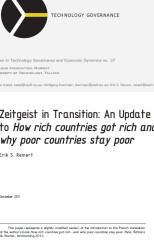
Author : Reinert Erik S.
Title : Zeitgeist in Transition : An Update to How rich countries got rich and why poor countries stay poor
Year : 2011
Link download : Reinert_Erik_S_-_Zeitgeist_in_Transition.zip
I am very pleased that this work is being made available in French. As is made clear in the book, many of the ideas in the book also have French origins, as in the prototype national strategy of Colbertism. Indeed, the first clear discussion of the need for national industrial policy in any language is probably in Barthélemy Laffemas’ 1597 Response aux difficultez proposees, containing 8 questions and answers, found as an appendix in some copies of his publication Reiglement general pour dresser les manufactures en ce rayaume, et couper le cours des draps de soye, & autres merchandises qui perdent & ruynent l‘Estat. The Colbertian principles of nation-building through the establishment of manufactures and the construction of infrastructure later formed the guidelines for the building of modern Europe. When the latest words in this book were written – during the last days of December 2006 – I formulated three predictions on the next to last page: ‘First of all, a major financial crisis is increasingly likely, and Keynesianism shall have to be re-invented in a new and global context. ‘Free trade’ as the centerpiece of the present world economic order is likely to delay the solution to future problems in much the same way as a stubborn belief in the ‘gold standard’ delayed Keynesianism in the 1930s.’ The first part of this prediction proved correct, the West had a major financial crisis in the private sector in 2008. As part of solving this crisis, the debt was taken over by the respective governments, opening up for the financial crisis which is still unfolding as these words are written. However, the second part of the prediction – that Keynesianism needs to be reinvented on a global scale – is not taking place, in spite of some early discussions in that direction in 2008. What we have mostly been seeing, both in the US and in the European Union, is the opposite of Keynesianism: the political gut feeling has been a monetarist one – cutting budgets and reducing national demand – rather than the Keynesian one of attempting to keep production, demand, and employment up. Europe and the United States are now experiencing the same kind of initial policies seen during the 1998 Asian crisis – a dress rehearsal for the present crisis, from which the West learned nothing – the intuitive reaction is to destroy industry in order to save banks. The verdict is still out on the third part of the prediction, the need to remove ‘free trade’ as the centerpiece of the world economic order. The Euro has proved to constitute a new version of the ‘gold standard’, impeding what European nations previously solved by frequent adjustment of exchange rates: economically ‘irresponsible’ nations have traditionally been forced to devalue. This had two beneficial effects: a) their economies were made internationally competitive again, and b) the value of the national debt, which was typically issued in the national currency, was simultaneously reduced. Italy has e.g. traditionally had a large public debt, but in lire. So far ‘free trade’ has survived, and instead of ‘trade wars’ we have ‘currency wars’. Currency wars, however, promote huge speculative activities and gains in the financial sector, while so-called ‘trade wars’ mainly affect employment and the real economy. The present economic strategy has already caused much harm in the European periphery. Greek protests are in focus, but in Latvia –another country in the European periphery – the economic hardships have generally gone unnoticed. A so-called ‘internal devaluation’ has cut real wages by up to 30 per cent. Unemployment and low living standards force people to leave the country, and the population has decreased by 20 per cent, from 2.38 million to 1.9 million since 2000. Latvian birth statistics reveal a culture under extreme pressure, as people stop having children. In 1987 42,000 children were born in Latvia, in 2010 only 18,000. Latvia follows the classical sequence of economic decay: 1. Deindustrialization (in the 1990s), 2. Deagriculturalization (death of agriculture), and 3. De-population. A similar trend towards de-industrialization coupled with falling real wages could first be observed in the Third World periphery, as expressed in Figure 14 in this book, using Peru as an example. After the 1989 fall of the Berlin Wall, the same mechanisms spread to the former Second World, the ex-communist sphere. Mongolia is used as an example in the book, but the same development – falling real wages and a fall in real wages as a percentage of GDP – also took place in Russia. Now, finally, this crisis created by a defective economic theory neglecting the important role of manufacturing and production in general is hitting the core of the First World itself: in the United States and in the European Union. The destructive forces of the neoliberal revolution first struck in the Third World, then in the Second World, only now to hit the First World. The technology and innovation-based strategy of Ireland, starting around 1980, is praised in this book. Its success was indeed startling. From 1986 to 1996 the Irish growth rate was more than twice that of the OECD average, 5.1 per cent annually vs. 2.4 per cent, and in 1996 the government budget deficit was virtually zero. Then, however, the Irish economy embarked on a speculative building spree, a bubble that burst, including the major mistake of the Irish government to bail out two leading banks, Anglo Irish Bank and Irish Nationwide Building Society. For this reason, Ireland’s general government deficit increased to the unheard of figure 32 per cent of GDP in 2010. So my analysis of the success of the Irish technology strategy still stands. This strategy also created an unusual case of ‘brain gain’, of qualified émigrés actually coming back to work in Ireland. Now this is all turned on its head again, not due to a failure in industrial strategy, but because Ireland entered into a speculative bubble and bailed out banks that should have been allowed to fail, as Norway and Sweden did a few years back. At this point in time the West – Europe and the United States – appear to be locked in the remnants of the Cold War debate, in empty ritual fights between ‘left’ and ‘right’, all equally imprisoned in the toolshed of mainstream economic ideology. Political extremes blame the government or big business respectively for the lack of economic dynamics, and the financial sector is in the driver’s seat both in Europe and the United States. In the West the belief in ‘the free market’ came with a stowaway, with an unwanted passenger: the ‘free market’ came to include the right of the financial sector to create as much money as they wanted, to lend this money to individuals (e.g. for subprime loans) and to nations (e.g. Greece) who should not have received the loans, and to send the bill for the defaulted loans to the taxpayers in the real economy. In other words, the ‘free market’ was defined as allowing the financial sector to create Ponzi schemes with implicit guarantees from the real economy. In this way the financial sector, which normally operates as an important scaffolding for the real economy – as a ‘bridge in time’ to use Keynes’ expression – instead became a parasite feeding on purchasing power in the real economy. Greece, which has had to reduce real wages permanently in order to pay banks, is but an early example of this economic parasitism. An interesting aspect of the financial crisis is that at one point in time financial crises, and the consequent need to control the financial sector, were well understood over the whole political spectrum from left to right. Marx – in volume 3 of Das Kapital – clearly understands financial crises, Lenin sees the end of capitalism when finance capital becomes dominant over industrial capital, and – although they differed in their policy recommendations – also politically conservative writers like Schumpeter and Keynes understood crises well. Figure 4 in this book essentially differentiates between Schumpeter’s Güterwelt – the world off goods and services – and the Rechenpfennige – the accounting units or jetons that inhabit the world of the financial sector. Also Hitler’s and Mussolini’s economists understood the importance of differentiating between schaffendes Kapital, capital that creates value, and raffendes Kapital, capital that only amasses wealth without creating anything. This Nazi typology was tragically used not only to picture England as an enemy, but also to create the murderous rhetoric towards Jews. Ironically, arguably the most important theoretical contribution to the understanding of financial capital was written by a Jewish social democrat who was killed by the Gestapo: Rudolf Hilferding, in his book Das Finanzkapital (1910). Remarkably, then, the understanding of financial crises was lost all along the political axis – from the extreme right to the extreme left. The understanding was lost when neo-classical economics – based on David Ricar do’s economics with no financial sector – became the only game in town. The present European crisis is so insurmountable in Europe because the ideologies neither to the political right nor to the political left have the necessary professional understanding of what is happening. Those who saw a financial crisis as a possibility found professional refuge only at a very few institutions, like The University of Missouri – Kansas City, and the Levy Institute outside New York. As we shall see later, this was not the only knowledge lost to present mainstream economics. When neoclassical economics – in the tradition of Quesnay and Ricardo – stopped distinguishing between the financial sector and the real economy, the economics profession in effect abdicated from studying financial crises. Not only that, the profession came to focus on trade and financial variables rather than on production and technology. These two theoretical defects – the failure to understand financial crises and the failure to have a realistic theory of technology and production – combine to be increasingly destructive to the Western economies. The pragmatic focus on the productive sector which characterizes China, India, and other Asian countries is now largely missing in the West. In Europe and the United States the financial sector has become the tail wagging the dog, i.e. the real economy. ...

Tourney Phillip - What I saw that day
Authors : Tourney Phillip F. - Glenn Mark Title : What I saw that day Year : 2011 Link download :...














